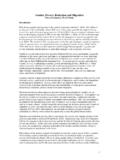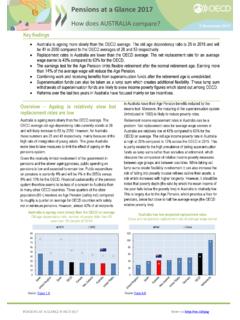Transcription of Lawrence Strike, 1912 - Westfield State University
1 94 Historical Journal of Massachusetts Summer 2012. Lawrence strike , 1912 . Massachusetts State Militia (National Guardsmen), armed with fixed bayonets, confront striking textile workers during the Lawrence Textile strike . Courtesy of the Walter P. Reuther Library of Labor and Urban Affairs, Wayne State University . Note: The Walter P. Reuther Library was founded with seed money from the United Automobile Workers and is the largest labor archive and one of the leading urban archives in the 95. Bread, Roses, and Other Possibilities: The 1912 Lawrence Textile strike in Historical Memory Mark W. Robbins Abstract: The 1912 Lawrence Bread and Roses textile strike was a signature moment in labor history that has captured public and scholarly attention for nearly a century. Taking place in the midst of the Progressive Era and the United States' greatest period of industrialization, the event held many meanings to its diverse participants and to onlookers throughout the world.
2 This historiographic essay explores the strike 's changing interpretations and legacies over the course of a century of debate, emphasizing how it lends itself to new methodologies of historical inquiry. Mark W. Robbins is a labor historian at Del Mar College in Corpus Christi, Texas. **. Few events in American labor history have captured the attention of as wide a range of people, past and present, as the 1912 Lawrence Bread and Roses textile strike . At the height of the Progressive Era and in the midst of the United States' greatest period of industrialization, thousands of impoverished Lawrence textile mill workers at the American Woolen Company (AWC) walked off their jobs when they discovered that their employer had reduced their wages. News of the work stoppage filled popular periodicals from Los Angeles to Italy. Laborers in Vermont, New York, and Poland cheered for the workers and offered their support.
3 Many were Historical Journal of Massachusetts, Vol. 40 (1/2), Summer 2012. Institute for Massachusetts Studies, Westfield State University 96 Historical Journal of Massachusetts Summer 2012. outraged when they read about the violence perpetrated by State militia and Lawrence police against employees, their wives and even their children. Yet others in the United States and elsewhere condemned the striking laborers, claiming that their radicalism threatened the fabric of free market capitalism. Whether strikers or observers from afar, a variety of people felt connected to what scholars have called the great textile strike , a moment of transnationalism of the Italian-American left, and a quintessentially American event. 1 The strike held many meanings to its participants and onlookers. It comes as little surprise that in decades of historiography on the event, scholars have similarly put forth diverse interpretations of the strike and its legacy.
4 Some scholars and public intellectuals have highlighted it as a moment in which workers proudly and successfully fought for both economic justice and respect. Others have criticized this argument as an agenda-driven attempt to impose present ideologies on the past, asserting that laborers fought for bread, but not roses or grander visions of the future. This article analyzes the changing interpretations of the strike through the lens of its historiography. Over the last fifty years, the event has served as the primary subject matter and analytical launching point for scholars in a wide variety of fields, including immigration studies, labor, gender and popular history, biography, anthropology, and the history of memory. For nearly a century, the strike has offered participants, onlookers and generations both within and outside of the academic community a multi-dimensional moment of inspiration and inquiry.
5 An event defined by its possibilities, the strike spoke to the hopes and dreams of a wide range of historical actors in 1912 . In the years that followed, it has provided interpretive possibilities for scholars reiterating, recovering and reshaping its purposes and legacies. THE strike . Ironically, a small victory for Massachusetts laborers set the stage for the 1912 strike . It did not occur on a picket line outside a textile factory, but in the halls of the Massachusetts legislature. At the time, both middle class progressive reformers and labor unions questioned the excesses of rapid industrialization. Enormous factories operated by wealthy men drew individuals from the rural and southern and eastern Europe to the United States' growing cities, where they lived in crowded housing in neighborhoods with inadequate social services or sanitation.
6 A predominantly immigrant working class labored for long hours in unsafe conditions for low pay. In The 1912 Lawrence Textile strike in Historical Memory 97. Workers and Their Families in 1912 during the Lawrence strike Courtesy: Bread and Roses Centennial Exhibit response to these conditions, both reformers and organized labor sought new laws that they argued would help the working class. In Massachusetts, reformers and the American Federation of Labor's (AFL) State branch lobbied the legislature to shorten the maximum work week from 56 to 54 hours for women and children, who made up half of the American Woolen Company's labor In spite of the AFL's support for the law, which was set to take effect on January 1, 1912 , many laborers worried that it would cut their total pay. While wages had remained the same after the last legislative mandate for a reduction in work hours in 1909, some employees asked AWC officials whether this time would be different.
7 They received no Wage earners at the AWC could ill-afford any reduction in pay, even if it meant two fewer hours of work. They lived in grinding poverty in a company town virtually controlled by AWC president William Wood. Wood owned the mills and some employee housing, and exercised a fair amount of influence over the local government and police. Rather than an exploiter of his workforce, however, Wood fashioned himself as the ultimate paternal figure. He claimed to care deeply about his employees, once referring to the American Woolen Company as a great humane institution. 4 After all, as he 98 Historical Journal of Massachusetts Summer 2012. liked to remind, he had himself worked his way up from working-class roots to become one of the wealthiest men in the United States. Wood expected his laborers to work hard, express loyalty to the company and respond to his directives.
8 The portrait of a caring paternal figure, however, was at odds with his employees' actual living and working conditions. The company's tenements, much like those in many urban areas, were dark, dirty, crowded, and often unsanitary. In the mills, his employees labored in dark and noisy settings for wages that usually demanded that both parents and children work. Working- class families in Lawrence were often undernourished and exhausted. Making matters worse, their work pace had recently been increased. In spite of a $3,000,000 profit in 1911, Wood reasoned that he couldn't afford to pay his laborers the same wages for two fewer hours of work per week. Although some union activists had predicted Wood's response, others, who had supported the law, mistakenly expected that Massachusetts employers would raise hourly wages to offset the reduction in On January 11, 1912 , a group of mostly Polish-American women weavers at the Everett Mill became outraged when their pay envelopes reflected the lower amount.
9 Many walked off their jobs in disgust, and thousands of Lawrence wage earners followed their lead. The difference in pay amounted to thirty to fifty cents or four loaves of bread and few would dispute that this was a significant amount to workers who lived from paycheck to paycheck. Accounts of the event vary, but a few features in particular garnered national attention. First, the strike highlighted a recurrent problem in American society. As a result of the uneven effects of rapid industrialization in the late nineteenth and early twentieth centuries, large strikes had become all too common in the United States. Lawrence was a central example. The sheer number of employees who participated led the New York Times to proclaim, strike Riots Close Big Lawrence Mill Eleven Thousand Made Idle, with other publications printing similar Second, workers of different ethnicities, both within and outside of Lawrence , cooperated to a degree that was atypical in the early-twentieth-century labor movement.
10 Third, the presence of the Industrial Workers of the World (IWW), an organization that sought a United States governed by one big union, captivated the attention of many. Famed IWW activists Joseph Ettor, Elizabeth Gurley Flynn, Big . Bill Haywood, and poet Arturo Giovanitti, among others, participated in the Lawrence strike . Scores of Americans were genuinely alarmed by their presence in one of the most significant labor conflicts of the era. The 1912 Lawrence Textile strike in Historical Memory 99. Left to right: Joseph Caruso, Joseph Ettor, and Arturo Giovannitti Notice that the three men are handcuffed to each other. This photo was taken while they were still in custody on the charges of murder and inciting a riot. Ettor's characteristic grin can be found in almost every photo of him. Caruso was a very active, Italian-American striker.










